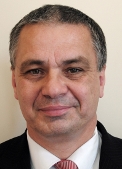|
|
|
Keynote talks
"How Rounds Can Be Fit by Squaring the Circle"Abstract When reading Kanatani's Bible on Stochastical Optimization for Geometric Optimization, one is struck by the general sophisticated statistics, applied to geometric coordinate representations that are hand-picked rather specifically for the problems at hand. In geometric algebra, on the other hand, we have a unified framework of coordinate-free representation for geometry, but are lacking the statistics. These fields clearly need to merge. As a first puzzle, we study the problem of fitting a model to data, which can be give both geometrical and statistical motivation. In this talk, I show how to solve the optimal least squares fitting to a set of data points of k-spheres (`rounds') in n-D (for instance, circles in 3D), using an isometric model of Euclidean space as provided by the (n+2)-D space of conformal geometric algebra (CGA). As an aside, this leads to a compact characterization of curved point data by a `conformal covariance'. Such tools might play an elementary role in a future `algebra of uncertain geometry'. 
"Percepts and Structure; In and Out of a Few Personal Traps"
Abstract Structural pattern recognition was forecasted a bright future after seminal contributions by Kung Sun Fu in 1970th. I learned in mid-1990th about the alternative approach to the subject allowing joint use of statistical and structural methods from my co-author while writing the book Schlesinger M.I., Hlavac V.: Ten lectures on statistical and structural pattern recognition, Kluwer 2002. Prof. Kenichi Kanatani was a conscientious reader of this book. I like to tell him and the audience of a seminar honoring him what I have learned about the subject since. I will mention several traps I fell to on my way. I will talk about my view of the subject in the reflection of our work: (1) in using 2D context-free grammars for analysis of mathematical formulae, (2) in using structure (pose primitives) in analysis of human activity from video; and (3) in recent project aiming at dual-robot manipulation with soft materials as pieces of garment.
|




